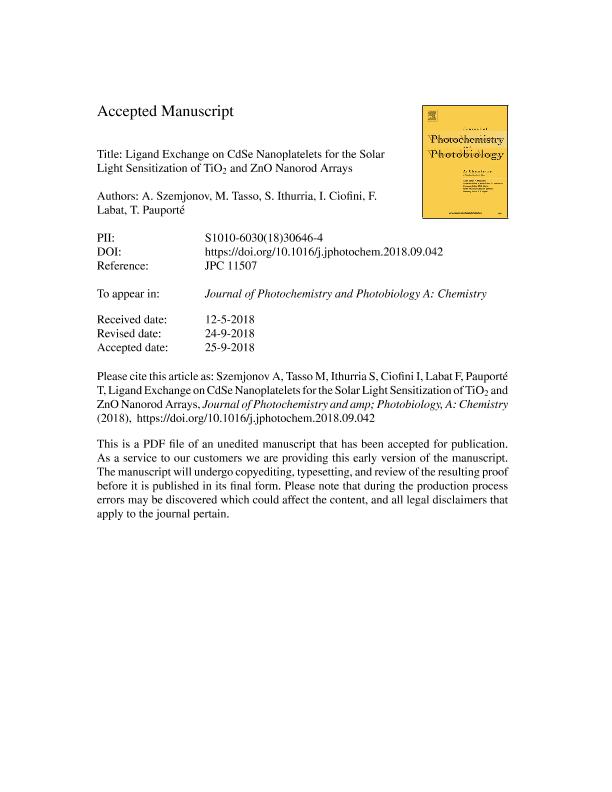Artículo
Ligand exchange on CdSe nanoplatelets for the solar light sensitization of TiO2 and ZnO nanorod arrays
Fecha de publicación:
01/2019
Editorial:
Elsevier Science SA
Revista:
Journal of Photochemistry and Photobiology A: Chemistry
ISSN:
1010-6030
Idioma:
Inglés
Tipo de recurso:
Artículo publicado
Clasificación temática:
Resumen
In quantum dot (QD) solar cells, the ex situ sensitization of wide band gap semiconductors (WBSCs) makes it possible to control the shape and the passivation of the nanosized sensitizer. Hence, ex situ techniques can be used to investigate how the band gap of the sensitizers affects the performance of quantum dot solar cells. The latter can be precisely controlled in 1D confined structures such as quasi-2D nanoplatelets (NPLs), the thickness of which is defined with an atomic precision. In this work, we tested and thoroughly characterized the attachment of 7, 9 and 11 monolayers thick CdSe NPLs (as well as QDs for the sake of comparison) to ZnO and to TiO2 nanorods. A crucial point of the ex situ techniques is the choice of bifunctional ligands that link the nanosized sensitizers to the WBSCs. Besides the well-known mercaptopropionic acid, we also studied two ‘atomic linkers’ (OH− and SH−) to minimize the distance between the sensitizer and the oxide. The as-prepared systems have been analyzed by UV/VIS absorption and Raman spectroscopy. Among them, SH− was found to be the most versatile linker that enabled the efficient attachment of all types of CdSe nanocrystals on ZnO and TiO2 nanorods.
Palabras clave:
CDSE
,
LIGAND EXCHANGE
,
LIGHT SENSITIZATION
,
NANOPLATELETS
,
TIO2
,
ZNO
Archivos asociados
Licencia
Identificadores
Colecciones
Articulos(INIFTA)
Articulos de INST.DE INV.FISICOQUIMICAS TEORICAS Y APLIC.
Articulos de INST.DE INV.FISICOQUIMICAS TEORICAS Y APLIC.
Citación
Szemjonov, A.; Tasso, Mariana Patricia; Ithurria, S.; Ciofini, I.; Labat, F.; et al.; Ligand exchange on CdSe nanoplatelets for the solar light sensitization of TiO2 and ZnO nanorod arrays; Elsevier Science SA; Journal of Photochemistry and Photobiology A: Chemistry; 368; 1-2019; 182-189
Compartir
Altmétricas




